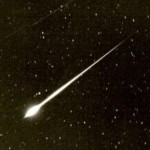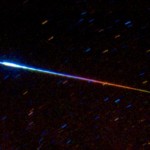Perseid Meteor Shower 2012
August 11, 2012 by staff · Comments Off on Perseid Meteor Shower 2012
Perseid Meteor Shower 2012, The Perseids Meteor Shower 2012 can work for you as a cheap date night, especially since it peaks in Golden Valley on Saturday night and into Sunday morning. The National Weather Service says that clouds will creep in tonight in Golden Valley, but you can see the annual meteor shower any night this week. Space.com tells us these objects are tiny bits of rock and debris from an old comet, which is named Swift-Tuttle after the astronomers who discovered it in 1862.
The shower splashes through the sky every year in early August when Earth passes through the comet Swift-Tuttle’s orbit and sweeps up some of this debris. We see shooting stars-rapid streaks of light-as the tiny rocks encounter the thin upper atmosphere of the Earth and the air is heated to incandescence.
For the geeks among us, here’s some trivia: The Perseids get their name from Perseus, the constellation from which they seem to emanate, but they can appear anywhere in the sky. Their only connection with Perseus is that, if you trace their path backward across the sky, eventually you get to Perseus.
You can see the shower anywhere in the sky, but look toward the southeastern sky to see the meteors at their brightest and longest.
So where to watch locally? Click here for a map of Golden Valley parks. Be mindful of park closing hours. The meteor shower will probably be most visible as the night goes on.
If you’re willing to travel, the Onan Observatory at Baylor Regional Park in Noorwood Young America just west of the Twin Cities is an option. The observatory is free to visit, but a parking pass is required to enter the park.
Meteor Shower August 2010 Time
August 13, 2010 by staff · Comments Off on Meteor Shower August 2010 Time
 Meteor Shower August 2010 Time, (Continental Post) — Viewing Metor shower? Where to see Metor shower? 2010 Perseid meteor shower begins tonight from 10 pm tonight at 3:00 a.m. on Friday. You can see Meteor Shower 2010 live without telescopes or experience. The best time is between 12:01 am and the morning of August 12 and the second will be from 18:00 Universal Time August 12 and August 13 7:00 Universal Time.
Meteor Shower August 2010 Time, (Continental Post) — Viewing Metor shower? Where to see Metor shower? 2010 Perseid meteor shower begins tonight from 10 pm tonight at 3:00 a.m. on Friday. You can see Meteor Shower 2010 live without telescopes or experience. The best time is between 12:01 am and the morning of August 12 and the second will be from 18:00 Universal Time August 12 and August 13 7:00 Universal Time.
The August Perseids are among the strongest annual meteor showers easily observed, and the yields of nominal maximum activity 90-100 meteors per hour, anyone in a city or near the bright lights nearby to see many less.
A meteor shower is a celestial event which saw a number of meteors radiating from a point in the night sky.
These meteors are caused by cosmic debris flows called meteoroids enter the Earth’s atmosphere at extremely high speeds on parallel paths.
Most meteors are smaller than a grain of sand, so almost all of them disintegrate and not hit the Earth’s surface. Intense or unusual meteor shower called as bursts of meteors and meteor storms, which can produce more than 1,000 meteors per hour
Metor Shower Tonight
August 13, 2010 by staff · Comments Off on Metor Shower Tonight
 Metor Shower Tonight, Metor shower tonight will be at best according to NASA officials. However cloudy atmosphere in parts of the United States is an obstacle to the spectacular view. NASA has predicted that there will be about 80 meteors per hour and the best time to see the light show is from 11:00 pm to 5:00 am for the sky would be dark during those hours. Those in the mountainous region may have more than 100 meteors per hour. People in the northern hemisphere will have a better view of the shooting star. Last year the meteor show was even better with about 200 meteors per hour.
Metor Shower Tonight, Metor shower tonight will be at best according to NASA officials. However cloudy atmosphere in parts of the United States is an obstacle to the spectacular view. NASA has predicted that there will be about 80 meteors per hour and the best time to see the light show is from 11:00 pm to 5:00 am for the sky would be dark during those hours. Those in the mountainous region may have more than 100 meteors per hour. People in the northern hemisphere will have a better view of the shooting star. Last year the meteor show was even better with about 200 meteors per hour.
A viewing guide is available on the NASA Web site to help viewers at home. Metor shower tonight called Perseids because the stars will point back to the constellation Perseus. Scientists have warned people to look up in the sky and the constellation to avoid any radiation affects.
Metor shower tonight is attributed to the comet named Swift-Tuttle. It takes 133 years for the comet to orbit the sun. concert tonight will be better visibility, as it is happening at a time when the moon is not so bright. The lights dim meteors will also be visible in the absence of moonlight. No special equipment is needed to see the light show. dark and less polluted sites offer a better view.
Those who do not leave free time in the morning of Friday, still have the chance to see the show on Saturday morning.
Perseid Meteor Shower Tonight
August 12, 2010 by Post Team · Comments Off on Perseid Meteor Shower Tonight
 Perseid Meteor Shower Tonight, The Perseid meteor shower peaks tonight, promising dazzling display fireball so sky watchers, but the rain cosmic space rock has not endangered the astronauts of the space station during their spacewalk repairs this week , a NASA scientist says. In fact, the meteor shower can give astronauts a show too.
Perseid Meteor Shower Tonight, The Perseid meteor shower peaks tonight, promising dazzling display fireball so sky watchers, but the rain cosmic space rock has not endangered the astronauts of the space station during their spacewalk repairs this week , a NASA scientist says. In fact, the meteor shower can give astronauts a show too.
The astronomer Bill Cooke, a meteor expert with NASA’s Meteoroid Environments Office, said the Perseid meteor shower adds a small amount of risk to astronauts on spacewalks (around 15 percent), but the odds of being beaten by a small meteor shower is scarce.
“The risk is still lower than the risk posed by orbital debris and other factors,” Cooke told SPACE.com of the Marshall Space Flight Center in Huntsville, Alabama
Currently, there is a 1-in-300 chance of a piece of orbital debris damage to space station astronaut or hitting a spacewalk. Compared to that, the slight increased risk of the shower is negligible.
A meteorite of about 1 millimeter in size is large enough to damage an astronaut’s spacesuit during a spacewalk, said Cooke. But NASA planners take spacewalk micrometeorites environment into account when scheduling trips, he said.
There are six astronauts living aboard the International Space Station, three Americans and three Russians.
The crew is in the midst of a difficult set of four spacewalks to repair the cooling system of the space station. One of the two ammonia coolant pumps vital 31 to July and station astronauts are fighting hard work to replace part of the oven the size of a spare. Spacewalks conducted Saturday through Wednesday, with the next scheduled for Monday.
If you’re lucky space station astronauts may be able to see meteors from above as you soar 220 miles (354 kilometers) above Earth’s night side. In the past, astronauts have been able to record video from meteorites from space during shuttle missions.
“You can definitely see the meteors, and it’s kind of cool,” said Cooke.
This sky map shows where to look to see the meteor shower. Sky watchers on Earth can use planet SPACE.com ‘s alignment chart to find and identify the planets appear together in the same time as the meteor shower.
During the Perseid meteor shower, the Earth is thrown by the remains of comet Swift-Tuttle when the planet passes near the comet’s orbit. Material left by the sheep committed in the Earth’s atmosphere during the pass at about 37 miles per second (60 km / second), the creation of an annual exhibition of “shooting stars” every mid-August.
One of the reasons why the Persians did not post a significant risk to the astronauts on the space station because, astronomically speaking, the astronauts are rather small, “said Cooke.
“When you look up in the sky, is about 10,000 square kilometers,” said Cooke. “An astronaut surface area is approximately 1 square meter, which is not too big a target.”
The space station is also small compared with the entire night sky, said Cooke. Still, the 100 billion and the International Space Station is the largest spacecraft built in each area and has a main truss, as long as a football field. You can easily outshine Venus on a clear night and be seen by the human eye.
Cooke plans to stay up all night the night to observe the peak of the Perseid meteor shower. The Marshall Space Flight Center intends to hear views live and their all-sky cameras in Alabama and Georgia over the Internet, he added.
“It is the first of the NASA-all night,” he said.
Meteor Shower August 2010
August 12, 2010 by staff · Comments Off on Meteor Shower August 2010
 Meteor Shower August 2010, The August 2010 meteor shower is expected to happen later tonight August 12, 2010. The meteors or shooting stars have already happening across the sky this week, but the peak is for the final hours Thursday night and early Friday, according to reports.
Meteor Shower August 2010, The August 2010 meteor shower is expected to happen later tonight August 12, 2010. The meteors or shooting stars have already happening across the sky this week, but the peak is for the final hours Thursday night and early Friday, according to reports.
The Perseids are so called as they arise come from the constellation Perseus. And humans have been able to see the Perseid meteor shower August each year about 2000 years, when Earth passes over the dust of the comet.
Notts Astronomer Phil Randall said “You can get 50 to 80 meteors an hour, so there is a fair chance you will see something.”
A small 1 inch (2.5 cm) thick meteor fireball caused when he met a burning August 3 disappearance while rays in Earth’s atmosphere, according to NASA’s Marshall Space Flight Center in Huntsville, Ala. The was pragmatic fireball in the sky to watch the cameras operated by the space center.
The fireball occurred at around 21:56 local time and was low in the sky when it entered Earth’s atmosphere about 70 miles (112.6 km) above the town of Paint Rock. Apparently, about 9.5 degrees above horizon. By contrast, the fist at arm’s length is equal to about 10 degrees in the night sky.
NASA spokeswoman Janet Anderson said: “It is a very good start this year’s Perseids meteor shower which will peak on the night of August 12-13 between midnight and dawn.” And NASA observations found the meteorite that travels through the atmosphere at a phenomenal 134.000 mph (215.652 kph).



